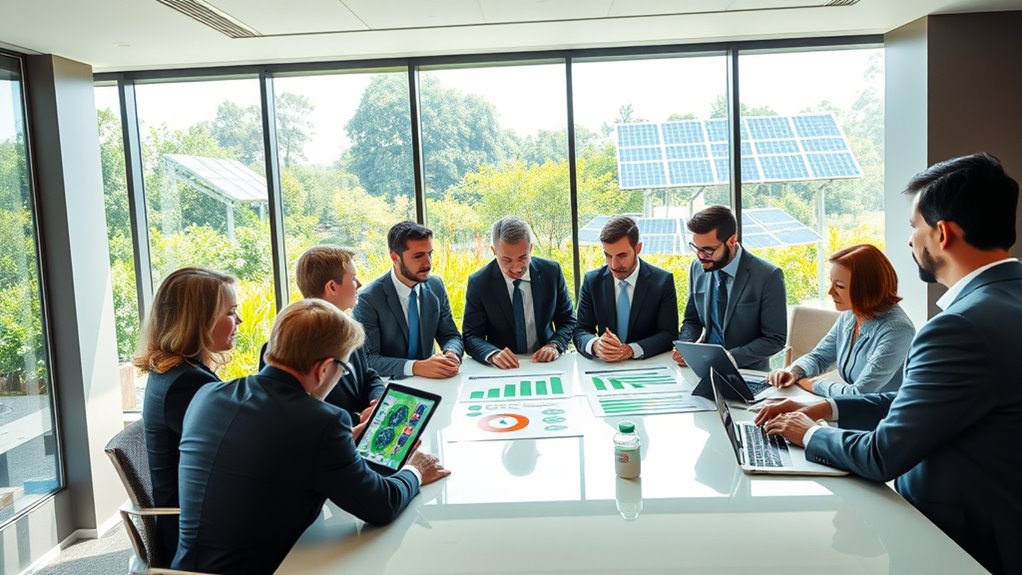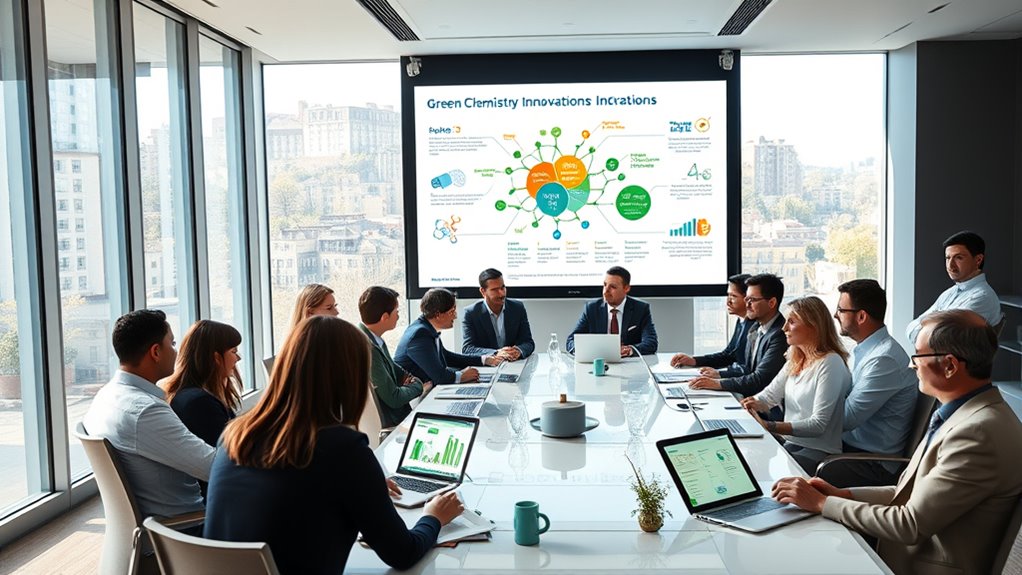Investing in green chemistry helps you stay competitive by meeting regulatory standards and customer demands for sustainability. It boosts your company’s innovation, reduces costs, and opens new market opportunities. While it requires capital, organizational changes, and advanced digital tools, building strong ecosystems and long-term strategies can accelerate your evolution. Embracing these practices positions you as a leader in the green economy—keep exploring to uncover how to capitalize on these opportunities.
Key Takeaways
- Early adoption of green chemistry standards enhances competitive advantage, compliance, and market differentiation.
- Regulatory policies and government incentives support sustainable investments, R&D funding, and scalable eco-friendly innovations.
- Integrating digital tools and cross-sector collaborations accelerates development, reduces costs, and improves transparency in green initiatives.
- Transitioning requires strategic capital allocation, organizational change, and resilient supply chains for bio-based raw materials.
- Long-term planning, scenario analysis, and policy alignment are vital for maintaining market leadership and sustainable growth.
The Strategic Importance of Green Chemistry for Industry Leaders

As industry leaders recognize the growing importance of sustainability, adopting green chemistry becomes a strategic imperative. Regulatory policies like the EU Chemicals Strategy and the Lautenberg Act push you to innovate responsibly, reducing legal risks and opening new markets. Recent Progress, Trends, and Future Outlook in Green & Sustainable Chemistry Support from legislation such as the Infrastructure Law, Inflation Reduction Act, and Sustainable Chemistry R&D Act provides substantial funding to facilitate this transition. Government incentives such as R&D funding and procurement preferences accelerate your investments, making sustainable practices more financially attractive. Investors now expect verifiable green chemistry metrics, tying funding to your sustainability commitments. Early adoption offers you a competitive edge through international standards, which can boost your market position. Embracing green chemistry not only helps you comply with evolving regulations but also enhances your reputation. This proactive approach positions your company as a leader in sustainable innovation, ensuring resilience and growth in a rapidly evolving global economy. Additionally, fostering a culture of creative practice can inspire innovative solutions to complex sustainability challenges, helping your organization stay ahead in the transition to greener practices.
Evaluating the Business Benefits of Sustainable Innovation

Have you considered how sustainable innovation can directly boost your business performance? By integrating eco-friendly practices into your product development, you can strengthen your business model and improve processes. Understanding sustainable innovation and its core principles This approach helps you meet customer demands for sustainable products and keeps you ahead of regulatory requirements. Incorporating environmental considerations into your strategy ensures long-term viability and compliance. Sustainable innovation also offers market advantages, differentiating you from competitors and creating new market segments. It enhances resilience, making your company more adaptable to change. Additionally, adopting sustainable methods reduces costs through efficient resource use, energy savings, and waste reduction. These practices can generate new revenue streams from innovative products and services. Overall, sustainable innovation not only supports global sustainability goals but also delivers tangible business benefits—driving growth, reducing risks, and reinforcing your market position.
Navigating Capital Investment and Organizational Change

Successfully shifting to green chemistry requires careful navigation of both capital investment strategies and organizational change. You need to secure funding from sources like venture capital, private equity, and new incentives from the Inflation Reduction Act, which lower costs and mitigate risks. The infrastructure supporting green chemistry is capital-intensive and requires significant investment, making it essential to identify long-term funding sources. Long-term, patient capital is essential for scaling sustainable technologies. You’ll also face the challenge of balancing upfront CapEx with the long-term environmental and regulatory benefits. Additionally, understanding the cost structure associated with green chemistry initiatives helps in strategic planning and securing stakeholder buy-in.
Shifting to green chemistry demands strategic funding and organizational adaptation for success.
Organizationally, integrating green chemistry involves cross-functional coordination among R&D, operations, and finance, along with employee training and culture shifts. Structural adjustments, such as revising procurement policies, are often necessary. Transparent stakeholder engagement builds support internally and externally. Overall, aligning investment strategies with organizational change ensures your transition to sustainable chemistry is both effective and sustainable.
Harnessing Digital Technologies to Accelerate Green Chemistry Goals

Harnessing digital technologies can markedly accelerate your green chemistry initiatives by making research, process optimization, and sustainability monitoring more efficient. With predictive analytics and statistical modeling, you’ll reduce experimental trials, cutting solvent and reagent use while speeding up development.
Digital simulations help design processes that generate less waste and improve atomic economy. Machine learning predicts reaction outcomes, minimizing trial-and-error. Digital records streamline compliance tracking and eliminate paper waste. Additionally, Kia Tuning techniques can be adapted to optimize process parameters for greener outcomes, further supporting sustainability efforts.
AI-driven tools forecast process efficiency, enabling real-time adjustments that conserve energy and resources. Automated quality-by-design systems align production with green principles, while lifecycle analysis tools quantify carbon footprint reductions.
Digital tracking, IoT sensors, and blockchain enhance material traceability and transparency. These technologies empower you to optimize circular economy practices and monitor sustainability KPIs effectively, advancing your green chemistry goals faster and more efficiently.
Aligning Regulatory Compliance With Sustainability Objectives

Regulatory compliance and sustainability objectives increasingly intersect as environmental laws and standards evolve to promote greener practices. You need to stay ahead of regulations like the U.S. Clean Air Act, TSCA, and the EU’s REACH, which mandate strict limits on emissions and chemical risks.
Global standards from ISO and ECHA set consistent benchmarks that you should align with. By integrating green chemistry principles into your processes, you can reduce hazardous substances, waste, and emissions, making compliance more manageable.
Transparent reporting and supply chain collaboration are key to meeting evolving disclosure requirements. Embracing sustainable chemistry not only helps avoid fines and sanctions but can also lead to cost savings, operational resilience, and market advantages—giving you a competitive edge in a shifting regulatory landscape. Practicing self-awareness through understanding your company’s environmental impact can further enhance your sustainability strategies.
Building Collaborative Ecosystems for Scalable Solutions

Building collaborative ecosystems is essential for developing scalable green chemistry solutions, as it brings together diverse expertise and resources needed to tackle complex environmental challenges. By uniting specialists from chemistry, engineering, environmental science, public health, and policy, you create innovative, safer processes and materials. Incorporating interdisciplinary teamwork accelerates the development and implementation of these solutions. These interdisciplinary teams accelerate technology development by integrating knowledge on toxicity, environmental impact, and economic feasibility. Partnerships between academia, industry, and government promote the translation of research into practical applications.
International collaborations and multi-sector alliances expand knowledge networks, share resources, and support capacity-building in developing regions. Innovation ecosystems and shared infrastructure further streamline R&D efforts, reduce costs, and enable rapid testing and deployment. Ultimately, fostering these ecosystems ensures scalable, impactful green solutions that address both technical and societal needs.
Overcoming Challenges in Transitioning to Bio-Based Raw Materials

Developing scalable green chemistry solutions requires overcoming significant hurdles in sourcing and using bio-based raw materials. Biomass diversity helps reduce supply risks and boosts sustainability, but balancing land use for biomass with ecological needs remains complex. Color accuracy is also a consideration when developing bio-based materials, as it can affect product appearance and consumer acceptance.
Local climate and soil conditions influence yield and availability, while seasonal fluctuations challenge supply consistency. Efficient supply chain development is essential to lower costs and environmental impacts.
Technologically, bio-based materials often need modifications to meet performance standards, and replacing harsh chemicals with greener alternatives is a major hurdle. Additionally, handling fibrous biological materials can cause processing issues.
Moving to renewable energy and implementing closed-loop systems further improve sustainability. Addressing these challenges demands strategic planning, investment, and innovation to open the full potential of bio-based raw materials in green chemistry.
Long-Term Planning for Competitive Advantage in a Green Economy

To gain a sustainable competitive advantage in a green economy, you must proactively align your corporate strategies with evolving national and international environmental policies. This includes leveraging subsidies, avoiding compliance costs, and developing partnerships with policymakers to shape green standards.
Monitoring trade policies like carbon tariffs and green export requirements helps you adapt sourcing strategies. Scenario planning for carbon pricing across regions ensures you’re prepared for future market shifts.
Advocating for stable long-term policies reduces investment uncertainty, enabling you to commit confidently to green innovations. Prioritizing R&D in scalable green chemistry processes, establishing cross-industry consortia, and accelerating patent filings secure market leadership.
Implementing eco-labeling, transparent supply chains, and sustainable warranties further differentiate your offerings, building operational resilience and long-term competitive advantage in a rapidly evolving green economy. Additionally, understanding the principles of nutritional value of chia seeds can inspire innovative sustainable ingredients and processes that support health-conscious product development.
Frequently Asked Questions
How Can Executives Measure the ROI of Green Chemistry Investments Effectively?
You can measure the ROI of green chemistry investments effectively by tracking cost savings from reduced waste, energy use, and hazardous materials, linking these to regulatory compliance and safety improvements. Incorporate environmental, health, and safety metrics, and assess long-term benefits like brand reputation and market access. Use all-encompassing techno-economic models and scenario analysis to compare traditional and green approaches, ensuring your metrics reflect true financial and sustainability gains.
What Are the Key Risks Associated With Transitioning to Bio-Based Raw Materials?
Think of shifting to bio-based raw materials as steering a ship through unpredictable waters. You face supply chain risks like seasonal shortages and regional variability, which threaten stability.
Higher costs, market volatility, and infrastructure gaps add to the turbulence. Environmental concerns and technological hurdles further complicate the voyage.
Staying aware of these risks helps you steer your organization safely toward sustainable innovation, balancing opportunity with caution in this evolving landscape.
How Do Regulatory Changes Impact Long-Term Green Chemistry Strategies?
Regulatory changes shape your long-term green chemistry strategies by encouraging safer, more sustainable practices while maintaining product safety and efficacy. They often offer clear guidelines and incentives that make adopting greener methods easier and more cost-effective.
You benefit from reduced regulatory hurdles, which promote innovation and competitiveness. Staying aligned with evolving policies helps you meet environmental goals, enhances your market reputation, and guarantees compliance.
Ultimately, these changes support your company’s sustainable growth.
What Skills and Organizational Changes Are Necessary for Successful Green Chemistry Adoption?
Did you know 85% of companies report skills gaps hinder green chemistry adoption? You need specialized training to develop expertise in sustainable practices and systems thinking.
Organizationally, establishing policies that promote innovation, fostering industry-academia partnerships, and investing in green technology infrastructure are vital.
You should also prioritize cultural shifts toward sustainability and guarantee compliance with regulations, creating an environment where green chemistry can thrive and deliver long-term benefits.
How Can Companies Balance Short-Term Costs With Long-Term Sustainability Benefits?
You can balance short-term costs with long-term sustainability benefits by carefully analyzing initial expenses against future savings and advantages.
Prioritize strategic investments like R&D and certifications that boost efficiency and reputation.
Leverage government incentives and focus on sustainable practices that reduce waste and operational costs over time.
Conclusion
By embracing green chemistry now, you can revolutionize your entire industry and outpace competitors in ways you never thought possible. The stakes are sky-high—miss this wave, and you’ll be left in the dust of those bold enough to lead the charge. This isn’t just a trend; it’s the ultimate game-changer that will define your company’s future. Act decisively today, or risk becoming irrelevant in a rapidly transforming, green-powered economy.









